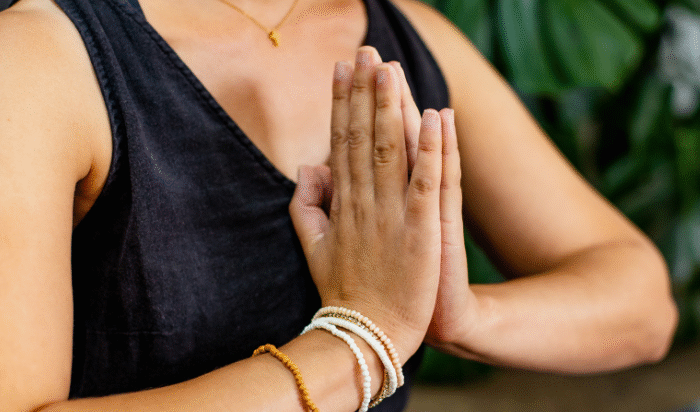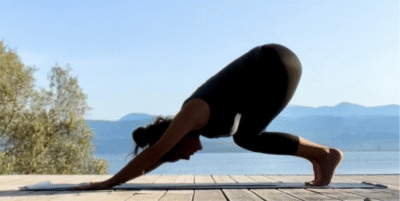What is Breathwork? 3 Breathwork Practices to Calm Stress for Beginners
Are you curious about what breathwork is and how you can use the practice to calm stress?
Breathwork is an umbrella term used to refer to various breathing exercises and practices. Breathwork techniques can vary widely in their approaches and goals, but they all focus on manipulating the breath in order to bring benefit to the body, mind, and spirit.
In this blog post, we will discuss breathwork for beginners and learn three simple breathwork techniques to help you manage stress, experience peace, and refresh your spirit.
Breathwork for Beginners: The Importance of Breath
In short, breathwork is simply the conscious practice of breathing! Breathwork techniques are a simple, yet effective way to reduce stress, increase mindfulness, and promote overall health.
As a teacher of yoga, I include breathwork techniques, also known as pranayama practices, in each of my yoga classes. I incorporate breathwork for beginners to invigorate the cells and tissues in our bodies while teaching simple pranayama practices to improve focus and concentration which is necessary for a yoga and meditation practice.
The Benefits of Breathwork Practices
There are many benefits of pranayama practices and breathwork techniques.
Both focus on balancing energies in the body, toning the nervous system, strengthening and cleansing internal organs by eliminating excess carbon dioxide from the body, and providing a rich supply of oxygen to the blood.
Research suggests that pranayama and breathwork practices improve the functions of the body including the respiratory system, circulatory system, digestive system, and endocrine system all while cultivating a sense of mental clarity and well-being.
Likewise, both can relieve stress. Deep breathing techniques activate the parasympathetic nervous system, which is responsible for the body’s “rest and digest” response. This counteracts the “fight or flight” response triggered by stress.
When we breathe consciously, slowly, and mindfully, deepening both our inhalation and exhalation, we reset our nervous systems and begin a cascade of amazing health benefits through our bodies. As a result, our heart rate decreases, blood pressure lowers, and our bodies enter into a state of relaxation.
Breathwork techniques have many benefits for our physical AND mental health, including:
- Decreased stress & stress response
- Increased mindfulness & brain function
- Improved respiratory & cardiovascular health
- Improved immune function & release of toxins
- Improved quality of sleep & energy levels
Breathwork vs Meditation
What is the difference between breathwork and meditation? Breathwork and meditation both focus on the mind-body connection and while they may have overlapping themes and similar outcomes, they differ in their approach and their techniques.
Some key distinctions between breathwork vs meditation include:
- Breathwork functions in the realm of the physical body working with the respiratory system while meditation functions in the realm of the mind working with our thoughts.
- Breathwork focuses primarily on the physical aspects of stress relief while meditation focuses on cultivating mental calm, clarity, and mindfulness through thought control.
- Breathwork is usually an active practice of breathing while meditation can be both an active process focusing on a single point of observation or a passive practice encouraging stillness and non-judgmental observation of thoughts.
Breathwork techniques can be utilized to enhance meditation. Pranayama, a set of yogic breathing techniques, is a perfect example of how breathwork can be integrated into meditation practices.
Incorporating breathwork techniques and pranayama practices into a meditation practice can produce a synergistic effect not only improving focus and mental clarity, but also reducing stress, and enhancing physical, mental, and emotional well-being.
3 Breathwork Techniques to Calm Stress
Breathwork techniques are powerful tools to help calm stress and reduce anxiety. When you’re feeling stressed, your body often goes into “fight or flight” mode, but controlled and intentional breathing can trigger the body’s relaxation response.
Deep breathing techniques activate the parasympathetic nervous system, which is responsible for the body’s “rest and digest” response. This counteracts the “fight or flight” response triggered by stress. As a result, your heart rate decreases,your blood pressure lowers, and your body enters a state of relaxation.
Here are a few examples of Breathwork techniques for beginners to help calm stress:
Deep Belly Breathing (Diaphragmatic Breathing):
- Find a quiet, comfortable place to sit or lie down.
- Place one hand on your chest and the other on your abdomen.
- Inhale slowly and deeply through your nose, allowing your abdomen to rise as you fill your lungs.
- Exhale slowly through your mouth.
- Focus on the rise and fall of your abdomen with each breath.
- Continue this pattern for a few minutes, allowing your breath to become slow and rhythmic.
4-7-8 Breathing:
- Sit or lie down in a relaxed position.
- Inhale quietly through your nose for a count of 4.
- Hold your breath for a count of 7.
- Exhale slowly and completely through your mouth for a count of 8.
- Repeat this cycle for several rounds, focusing on the counts and the calming effect of the breath.
Box Breathing (Square Breathing):
- Inhale for a count of 4.
- Hold the breath for a count of 4.
- Exhale for a count of 4.
- Hold the breath again for a count of 4.
- Repeat this square pattern for a few minutes. This technique can help regulate your breath and calm your nervous system.
Breathing Techniques, Getting Still, and Awakening to God’s presence
“Again Jesus said, ‘Peace be with you! As the Father has sent me, I am sending you.’ And with that, he breathed on them and said, ‘Receive the Holy Spirit.’” John 20:22 NIV
Pranayama can be a powerful spiritual practice for Christians. Yoga teaches us the art of getting still and the breathwork techniques found in a Pranayama practice not only offer physical and mental benefits but offer spiritual benefits for Christians as well!
Breathwork techniques found in a pranayama practice can serve to remind Christians of the ‘breath of Life’ breathed into us by our Heavenly Father in the Garden and to awaken us to the presence of the Holy Spirit who lives among us and within us. (Genesis 2:7 & John 20:22)
Much like the Holy Spirit, our breath is our constant companion, always present with us whether we are aware of it or not! Neither the “breath” around us nor God’s Spirit fluctuates, but instead, we can get still and RECEIVE both of these things that never waver.
When practicing Pranayama as Christians, we become aware of the steady and constant presence of the breath in our lungs and the Holy Spirit in our souls and we are quickened to receive.
As we get still, awakening to the Holy Spirit, we can look past the stress and chaos and instead set our gaze on the Spirit of God who is always present with us!
Learn More Through My Free Resources
Wanna learn more about meditation, yoga, and chakras? Check out my free resources here.
Longing for a more embodied faith?
Practice, connect, and cultivate a deeper relationship with God in The Yoga Abbey– your online sanctuary for Christ-centered yoga, meditation, and prayer.
Join today and get instant access to over 1,000 Christ-centered yoga, meditation, and contemplative prayer practices!






